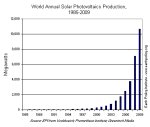For those with serious investment in the progress of the solar energy industry – be it financial or just a hope for a more renewable energy focused future – the results of a new study from the Earth Policy Institute must come as very welcome news indeed.
According to Earth Policy Institute (EPI) researcher J. Matthew Roney, manufacture of solar photovoltaic (PV) cells around the world grew by 51 percent in 2009, or to put that in terms of renewable energy generated, a record 10,700 megawatts of PV cells globally.
Roney’s report states solar PV energy system technology is the world’s fastest growing source of power. By the end of 2009, nearly 23,000 megawatts of PV had been installed worldwide, enough to power 4.6 million U.S. homes.
The study recognises China as the world’s biggest producer of crystalline solar PV cells, with Japan in second, followed by Taiwan. But it was an Arizona company, with its manufacturing plants working mainly out of Malaysia, that leads the pack in the production of new thin-film solar cells, contributing roughly 10 percent of world PV production in 2009.
Although the EPI report’s findings are not exactly breaking news – there have been several others outlining statistical growth in solar cell manufacture, including the USA government’s National Renewable Energy Laboratory – one key finding reinforces what solar energy companies and consumers have known for years: the major contributing factor to growth in global solar PV technology is government feed-in tariff schemes.
A feed-in tariff pays the owner of a renewable energy system such as a rooftop solar power system a premium cash rate for electricity they feed back into the power grid.
Roney’s report quotes Deutsche Bank estimates that feed-in tariffs had driven 75 percent of world PV installations as of 2008. It also recommends that “although PV production and installation costs have fallen substantially over time, government support will be necessary until solar reaches grid parity . . . with heavily subsidized fossil fuels.”
Germany, in particular, has had such success with its feed-in tariff policy that the government announced that with PV system prices plummeting, including a 30-percent drop in 2009 alone, in mid-2010 it would reduce tariff rates, with solar energy reaching possible grid parity by 2013 in that country.












































